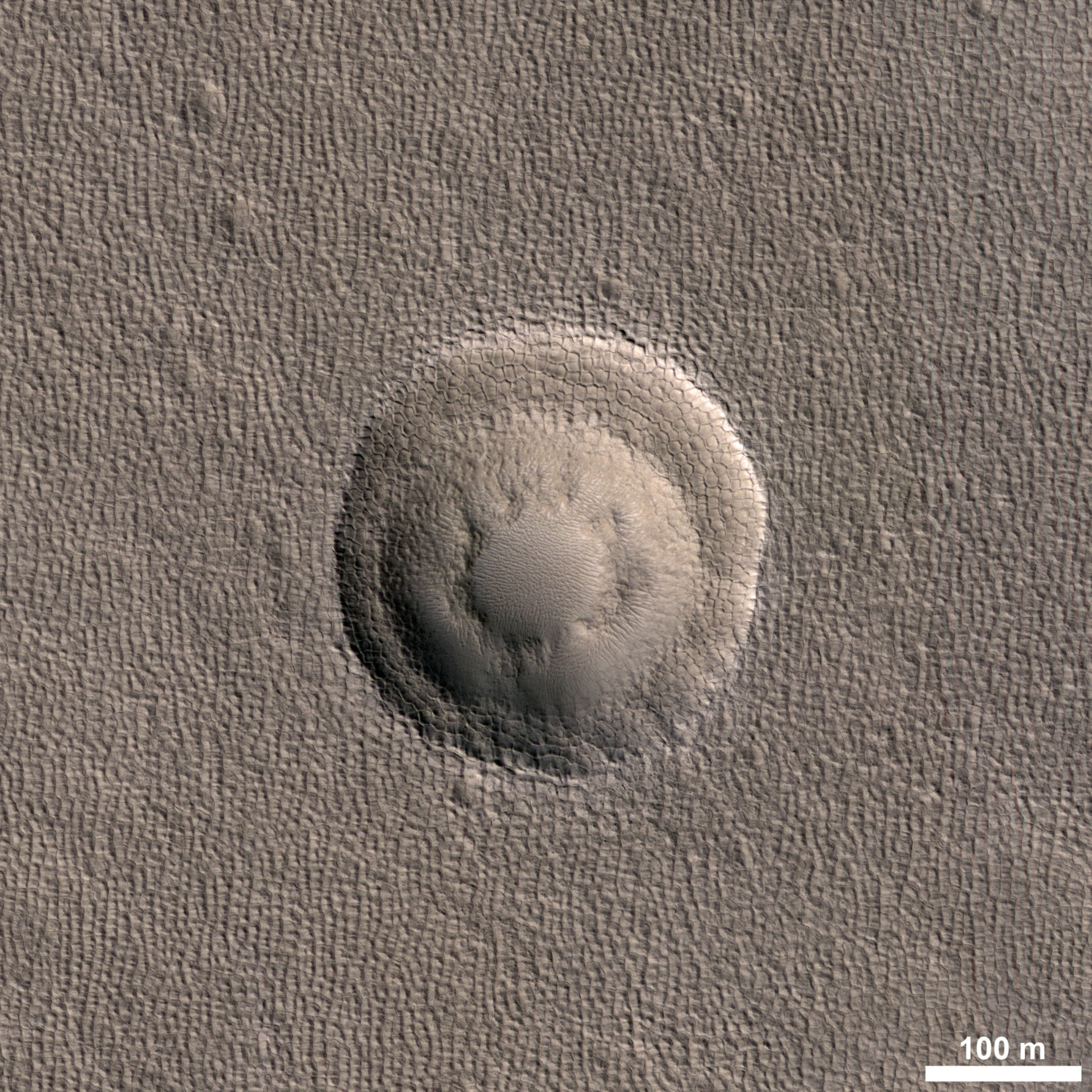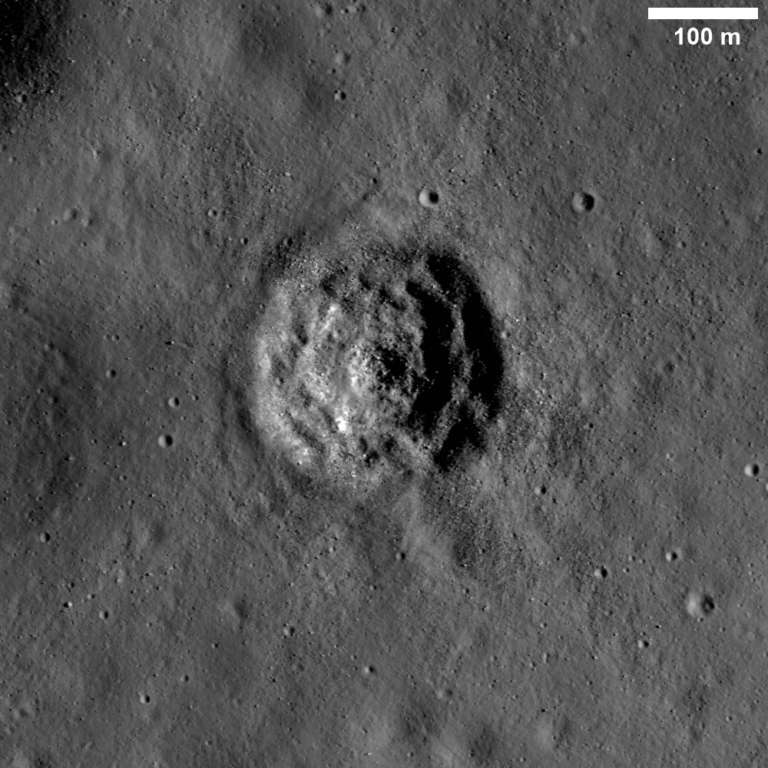Emily Lakdawalla • Feb 27, 2014
Pretty pictures of terraced craters on Mars
Check out this unusual crater on Mars. It's not a very big one, less than 500 meters in diameter, and yet it has two rings. Most craters on Mars this size are simple bowl shapes. What's going on here?

One possibility is that we're looking at a nested pair of craters -- one happening to strike dead center in the middle of another. But that doesn't explain the otherwise flat floor of the larger crater, and requires quite a coincidence. Instead, it's more likely we're looking at a spot on Mars where the ground is layered. There's an upper layer with different mechanical properties than the lower layer. To oversimplify, the upper layer is weaker than the lower layer, so the impactor can dig a bigger hole out of it.
Here's another crater in the same region, with not two but three distinct layers. I cut the same-size piece out of a HiRISE image as the one above, so both pictures cover an area 700 meters square.

Terraced craters aren't only found on Mars. They're on the Moon as well:

Can we learn something about what's happening underground from the depth to the different terraces? Here's a passage from Jay Melosh's 1989 textbook on Impact Cratering, talking about what terraced craters tell us:
The most fully studied case is the effect of layering when a weak layer overlies a strong half space. This situation is common on the moon, where a loose, fragmental regolith overlies consolidated lava flows in the mare regions. This situation was studied experimentally by V. R. Overbeck and W. L. Quaide in the late 1960s. They found that the morphology of the final crater depends sensitively on the ratio between the crater's rim-to-rim diameter and the layer thickness. When [the diameter of the crater is less than four times the layer thickness] the crater has a normal bowl-shaped morphology. When [the crater is between 4 and 8 times wider than the layer thickness], however, a low central mound forms in the bottom of the crater on the strong layer. This mound is composed of unexcavated weak material. The streamtubes that would normally have carried this material farther down or out of the crater intersect the strong layer and motion in them stops sooner than for the rest of the flow. When [the crater is 8 to 10 times the layer thickness], the flow is strong enough to excavate the weak material from the crater floor, which is flat, constituting an exposure of the strong layer's top. Finally, [when the crater is more than 10 times the layer thickness] a crater forms in the strong layer as well, but the strength transition is demarked by a bench or shelf on the wall of the final crater at the horizon of the strong layer. As the crater diameter increases beyond this final transition, the bench occurs progressively higher up the crater wall and becomes less conspicuous.
Another way of looking at that: whenever you see a two-level terraced crater, you automatically know there's a layer boundary in the subsurface at something less than one tenth the diameter of the crater.
On the Moon, it's obvious what the weaker upper layer and stronger lower layer are: the upper layer is regolith (unconsolidated blocky material, the pulverized wreckage of rocks left behind by billions of years of impact cratering), and the bottom layer is consolidated rock. Studying terraced craters can tell you how deep the boundary is between regolith and rock.
On Mars, things are a little different; we don't necessarily know what the difference is between the different layers. It could be a contrast between regolith and rock, or it could be something else entirely. In the two craters that I showed you, there is smoking-gun evidence that ice is involved here. You can tell there is ice quite close to the surface in the two craters I showed you because of the polygonal patterns in the ground. Here's a detail view at full resolution. The ground outside the crater is polygonally patterned, and so is the first terrace, but the polygons peter out as the crater drops into the second terrace. After that, it's difficult to see what's going on because there are sand ripples filling the innermost crater.
This kind of polygonally patterned ground often forms in permafrost environments on Earth, where thermal contraction breaks the surface into polygonal shapes and then ice wedges form in between them. Thanks to Phoenix, we know that at least some of these polygonal terrains on Mars actually contain quite pure ice in the polygons themselves, quite close to the surface. Here's Phoenix's view of its landing site, in the middle of polygonally patterned ground:

And here's what it looked like where Phoenix' descent engines blasted away a few centimeters worth of dry soil:

These terraced craters are cool because they provide a way to check how thick the pure-ice layer is. The terraces form where material properties change, so they probably show you the thickness of the ice layer, right? Well, maybe.
The reason so many images of these craters are showing up is because scientists are using these pictures to ask these questions and figure out the answers right now. Specifically, Ali Bramson is working on this project as part of her graduate work with Shane Byrne. (Check it out, kids, you can do some pretty neat research in space before you even have a Master's degree, never mind a Ph.D.) You can see the progress they're making by reading two Lunar and Planetary Science Conference abstracts, one from last year and one that Ali will be presenting in a couple of weeks. So far, they've managed to show with the help of Mars Reconnaissance Orbiter SHARAD data that the upper layer is most likely fairly pure ice. However, they've also shown that in many cases there are terraces in craters within the ice-rich layer -- there's some change in material properties in the icy layer as you go down, "perhaps a change in porosity or dirtiness of the ice."
So yes, there's ice below the surface where we see terraced craters; but it's ice that varies in its strength for some reason as you go down. How? Why? We don't know. Which is a good example of how, in planetary science, a single study can both confirm a hypothesis and raise new questions!
Support our core enterprises
Your support powers our mission to explore worlds, find life, and defend Earth. You make all the difference when you make a gift. Give today!
Donate

 Explore Worlds
Explore Worlds Find Life
Find Life Defend Earth
Defend Earth


